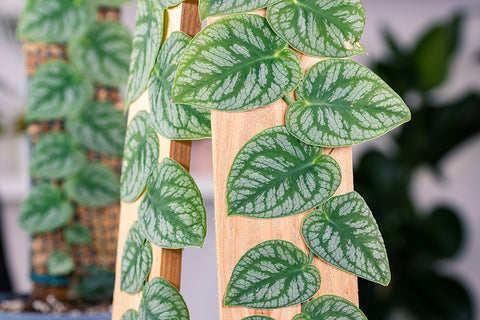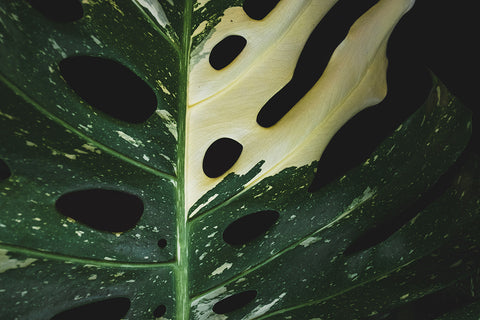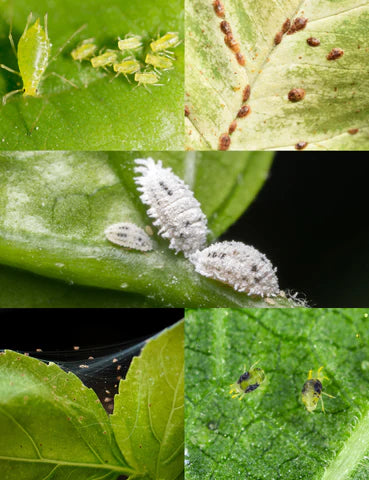Monstera Plant Care Guide
HOW TO GROW AND CARE FOR MONSTERA
By Julianne Blackaby | 25/09/2023

📷 Monstera deliciosa, Chalet Boutique
|
Common Varieties |
Monstera deliciosa, Monstera adansonii, Monstera obliqua, Monstera adansonii variegata, Monstera deliciosa 'Borsigiana,' Monstera pinnatipartita, Monstera Thai Constellation, Monstera Albo Variegata, Monstera 'Esqueleto', Monstera peru (Monstera karstenianum), Monstera dubia |
|
Botanical Name |
Monstera spp. |
|
Family |
Araceae |
|
Plant Type |
Tropical vine |
|
Mature Size |
Varies by species and variety, but typically ranges from 1 to 3 meters in height indoors. |
|
Light |
Bright, indirect light, although some can tolerate lower light conditions. Avoid direct sunlight. |
|
Soil Type |
Chunky aroid mix |
|
Native Areas |
Native to tropical regions of Central and South America. |
|
Toxicity |
May be toxic to dogs and cats |
Monstera plants encompass a wide array of varieties, each with its unique characteristics and charm. These plants are immensely popular with house plant enthusiasts and gardeners due to their striking foliage and ease of care.
One of the most iconic Monstera varieties is the Monstera deliciosa, often known as the Swiss cheese plant, celebrated for its distinctive fenestrated leaves. The Monstera adansonii, also known as the Swiss cheese vine, is another beloved choice, featuring smaller, heart-shaped leaves adorned with captivating holes. Additionally, the Monstera obliqua, prized for its delicate, fenestrated foliage, is highly coveted by collectors for its rare beauty. With its thick leather like leaves, the Monstera Peru are easy to care for, and unlike other plants, they do not require constant pruning or trimming to maintain their size and shape. The Monstera pinnatipartita stands out with its intricately lobed leaves and vibrant greenery among the Monstera family. The Monstera standleyana, with its striking variegated patterns, adds a touch of elegance to any space. These are just a few examples from the diverse world of Monstera plants, showcasing the variety and appeal that make them a favourite among plant enthusiasts worldwide.
Our guide will provide all the information you need to keep your Monstera healthy and content, including tips on light and temperature needs, watering, fertilising, and how to propagate your plant. Let's embark on the journey of Monstera plant care together!
WELCOME TO YOUR COMPLETE GUIDE TO CARING FOR MONSTERAS

HOW MUCH LIGHT DOES A MONSTERA NEED?
Monsteras are tropical plants that thrive in bright, indirect sunlight. To provide optimal lighting for Monsteras, place them in an area of your home that receives bright, indirect light throughout the day. This could be in front of a window covered by sheer curtains or in an area with bright indirect sunlight. Avoid placing Monsteras in direct sunlight, as this can burn the leaves. In addition, Monsteras like warmth and humidity, so if you want to keep them healthy and happy, it's essential to provide a warm environment with adequate humidity. You can increase the humidity for your Monsteras by grouping them with other plants to create a microclimate.
HOW OFTEN SHOULD I WATER A MONSTERA?
Monsteras prefer "moderate" irrigation. In the world of houseplants, moderate watering means watering when the soil feels moist 3-5cm below the surface. Gently press your finger into the earth, about two knuckles deep. You can put off watering if the soil still seems moist that deep down. If it's dry, it's time to rehydrate your monstera!
We've discovered that putting your monstera in the sink or using a watering can to slowly add water until it starts to run out the drainage holes is the best approach to water it. Immediately empty the drainage tray. Monsteras dislike being overwatered, so make sure your container has good drainage and that the soil drains rapidly.
WHAT IS THE BEST POTTING MEDIUM FOR MONSTERA?
A mixture of potting soil, orchid bark, and sphagnum moss is an excellent medium for Monsteras to grow. This combination contains the necessary nutrients and retains the right balance of moisture and drainage, which is ideal for Monsteras. The potting soil should be high-quality and well-draining, and the orchid bark should be coarse-grade and free of contaminants. The sphagnum moss should be fine-grade and used to retain moisture for the roots. This mixture will provide an ideal environment for the Monsteras, ensuring healthy, lush growth.

WHAT IS THE BEST TEMPERATURE FOR MONSTERA TO LIVE IN?
Monsteras thrive in normal household temperatures. Extreme cold or being near air conditioning is not recommended.
WHAT IS THE BEST HUMIDITY FOR MONSTERA?
Monsteras are tropical plants and thrive in high humidity levels. The ideal temperature range for optimal growth is between 18-30 degrees Celsius and relative humidity of at least 60-80%. If the humidity is too low, the leaves may start to curl, and the plant may become susceptible to pests and diseases. You can use a humidifier or place the plant on a humidity tray to increase the moisture. With proper care, Monsteras can provide a beautiful and unique addition to any home.
TRAINING MONSTERA ONTO A TRELLIS
Monsteras are easy to train onto a trellis or pole, and doing so can enhance their growth and appearance. Here are the steps you can follow to prepare your Monstera to grow onto a trellis or pole:
- Choose a sturdy trellis or pole tall enough to support the growing plant. The trellis should be made of a material the plant can easily attach itself to, such as bamboo or plastic.
- Position the trellis inside the pot, so it is directly in contact with the soil, ensuring it is stable and secure.
- Guide the plant's stems towards the trellis or pole, not damaging the leaves or roots.
- Use plant ties to attach the stems to the trellis or pole. Ensure the ties are not too tight and do not damage the stems.
- As the plant grows, guide its stems towards the trellis or pole and secure them with ties.
- Prune any stems not growing towards the trellis or pole, as this will encourage the plant to focus its energy on the trained stems.
- Water the plant regularly and fertilise it once a month to encourage healthy growth.
Following these steps, you can train your Monstera onto a trellis or pole, creating a beautiful and healthy plant to enhance any room or outdoor space.
WHAT IS THE BEST FERTILISER FOR A MONSTERA?
We use Growth Technology, Foliage Focus for all our Tradescantias, here's why:
- Each GT Focus product is complete. Unlike the overwhelming majority of fertilisers, all Focus products contain each of the 12 essential minerals – including Calcium – blended into an easily absorbed liquid concentrate.
- pH buffered to ensure all 12 essential minerals are available to the plant.
- Formulated and balanced to suit the requirements of specific plant types.
- Manufactured using only the highest-grade raw materials and chelated trace elements to ensure effortless absorption by the plant.
- Guaranteed not to contain potentially harmful and ineffective chlorides, urea, sodium and ammonium.
- Easy to use with simple instructions.
- Makes up to 200 litres of working solution
WHAT ARE COMMON MONSTERA PESTS, AND HOW DO YOU TREAT THEM?
Monstera can be susceptible to various pests, including aphids, mealybugs, spider mites, and scale insects. The use of beneficial insects such as ladybugs, lacewings, and parasitic wasps can be effective biological control against these pests.
Aphids are small, soft-bodied insects that feed on plant juices. They can be identified by their pear-shaped bodies, usually black, green, yellow, or brown. Aphids can weaken the plant by sucking out its sap, leading to yellowing and/or wilting leaves. Treatment for aphids includes spraying the plant with a strong water stream or using an insecticidal soap or neem oil solution.
Mealybugs are small, white, fuzzy insects that feed on plant sap. They are usually found in clusters on the underside of the leaves. Mealybugs can be treated with insecticidal soap, neem oil, or a cotton swab dipped in rubbing alcohol to wipe them off.
Scale insects are tiny, flat, oval-shaped pests that feed on plant sap. They can also be identified by the white, waxy coating they produce. Treatment for scale insects includes wiping them off with a cotton swab dipped in rubbing alcohol or spraying the plant with neem oil.
Spider mites are tiny, eight-legged arachnids that feed on plant sap. They cause yellowing and stippling of the leaves and webbing on the foliage. Treatment for spider mites includes spraying the plant with Kill-a-mite or Stealth. By monitoring these common pests and treating them promptly, you can ensure your plant stays healthy and thrives.

Top Left: Aphids, Top Right: Scale, Middle: Mealybugs, Bottom: Spider mites
HOW TO PROPAGATE A MONSTERA
Propagating a Monstera is relatively easy and can be done in two ways: stem cuttings or air layering. To propagate a Monstera through stem cuttings, carefully cut a stem off the plant and remove all lower leaves. Place the stem in a jar of water and wait for roots to form for approximately 1-3 weeks. When roots have formed, pot the stem in soil and water regularly. To propagate a Monstera through air layering, cut into the stem of a plant and remove a small section of bark. Wrap the wound with damp sphagnum moss and secure it with plastic wrap. Wait for roots to form, approximately 1-3 weeks, then cut the stem below the moss, pot in soil and water regularly.

WHEN DO YOU NEED TO REPOT A MONSTERA?
When a Monstera grows too large for its current pot, it is time to repot it. You should also repot your Monstera if the soil is depleted or filled with pests or diseases. If the roots have grown too large and are pushing against the sides of the pot, or if you notice the roots are growing out of the drainage holes, it is time to repot. Additionally, monsteras should be repotted every two to three years to refresh the soil and give the plant more space and nutrition.
WHAT SORT OF POT DOES A MONSTERA LIKE?
Monstera plants prefer to be kept in a pot with plenty of drainage holes. They need a pot slightly larger than their root ball, as they can grow quite large over time.
ARE MONSTERAS TOXIC TO PETS AND CHILDREN?
Yes, many Monstera species are considered toxic to pets and children. The leaves and stems of Monstera plants contain oxalate crystals, which can cause irritation and discomfort if ingested. Common symptoms of ingestion may include mouth and throat irritation, drooling, difficulty swallowing, and gastrointestinal upset.
It's essential to keep Monstera plants out of reach of pets and children to prevent accidental ingestion. If you suspect that a pet or child has ingested any part of a Monstera plant and they exhibit severe symptoms, it's advisable to seek immediate medical attention.
As a precaution, always be aware of the potential toxicity of houseplants and take measures to keep them in safe locations, especially if you have curious pets or young children in your household.

📷 Monstera siltepecana, Chalet Boutique
Monstera variety list of the most popular and commonly found
- Monstera adansonii
- Monstera deliciosa
- Monstera dubia
- Monstera obliqua
- Monstera siltepecana
- Monstera deliciosa variegated
- Monstera peru (Monstera karstenianum)
- Monstera pinnatipartita
- Monstera borsigiana
- Monstera standleyana (Philodendron cobra)
- Monstera Thai Constellation
- Monstera borsigiana 'Albo Variegata'
- Monstera 'Esqueleto'
- Monstera 'Lechleriana' (Monstera Lechleriana)
- Monstera adansonii 'laniata'











Comments
Jean U. said:
04-22-24:
Hi. Thanks for the related care & maintenance information for the Swiss Cheese Plant, my favorite one in the collection, for the Swiss cheese type of plant leaves. I absorb it’s information because I care a Lot if it does well.
Sincerely:
Jean.
jeanu687@gmail.com
Beverly said:
My monstera deliciosa variegated plant has 1/2 white and green leaves but the white is dying